BUACC5935: Audit and Assurance Services - Quality and Ethics Report
VerifiedAdded on 2022/09/16
|14
|3828
|16
Report
AI Summary
This report provides a comprehensive analysis of audit quality and assurance services, addressing key issues such as financial scandals (including Enron and the Commonwealth Bank of Australia) and the importance of ethical standards. It explores the role of the restructured Code of Ethics in providing quality audits and examines how technology, particularly artificial intelligence, data analytics, and robotic process automation, can improve audit processes. The report highlights the challenges and opportunities in the field, supported by relevant examples and case studies, offering insights into how auditors can leverage technology to enhance their work and maintain public trust, while adhering to ethical guidelines. The discussion also covers the role of ASIC in maintaining audit quality and the importance of the IESBA code of ethics.

Running Head: AUDITING AND ASSURANCE SERVICES
AUDITING AND ASSURANCE SERVICES
Name of the Student
Name of the University
Author Note
AUDITING AND ASSURANCE SERVICES
Name of the Student
Name of the University
Author Note
Paraphrase This Document
Need a fresh take? Get an instant paraphrase of this document with our AI Paraphraser
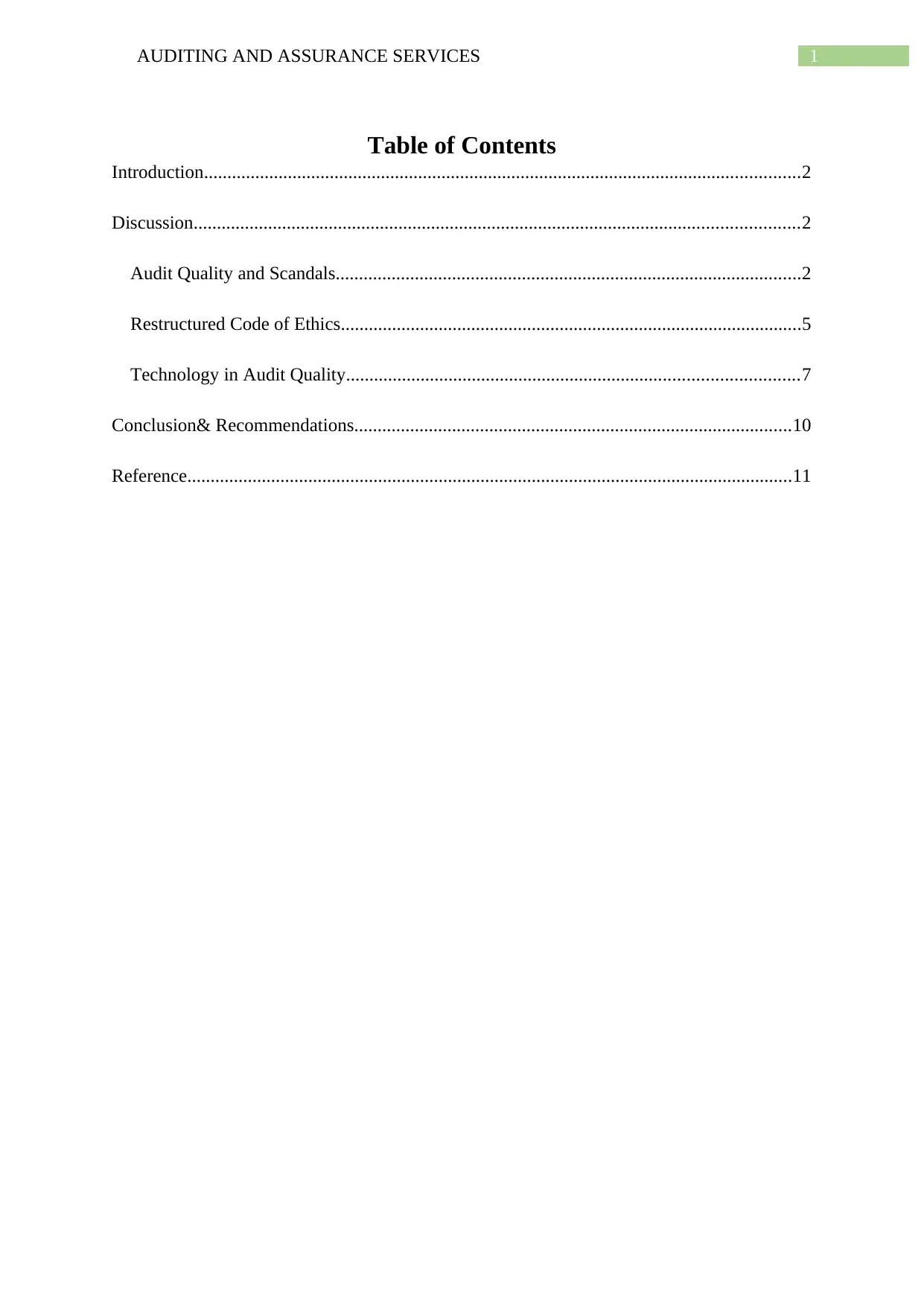
1AUDITING AND ASSURANCE SERVICES
Table of Contents
Introduction................................................................................................................................2
Discussion..................................................................................................................................2
Audit Quality and Scandals....................................................................................................2
Restructured Code of Ethics...................................................................................................5
Technology in Audit Quality.................................................................................................7
Conclusion& Recommendations..............................................................................................10
Reference..................................................................................................................................11
Table of Contents
Introduction................................................................................................................................2
Discussion..................................................................................................................................2
Audit Quality and Scandals....................................................................................................2
Restructured Code of Ethics...................................................................................................5
Technology in Audit Quality.................................................................................................7
Conclusion& Recommendations..............................................................................................10
Reference..................................................................................................................................11
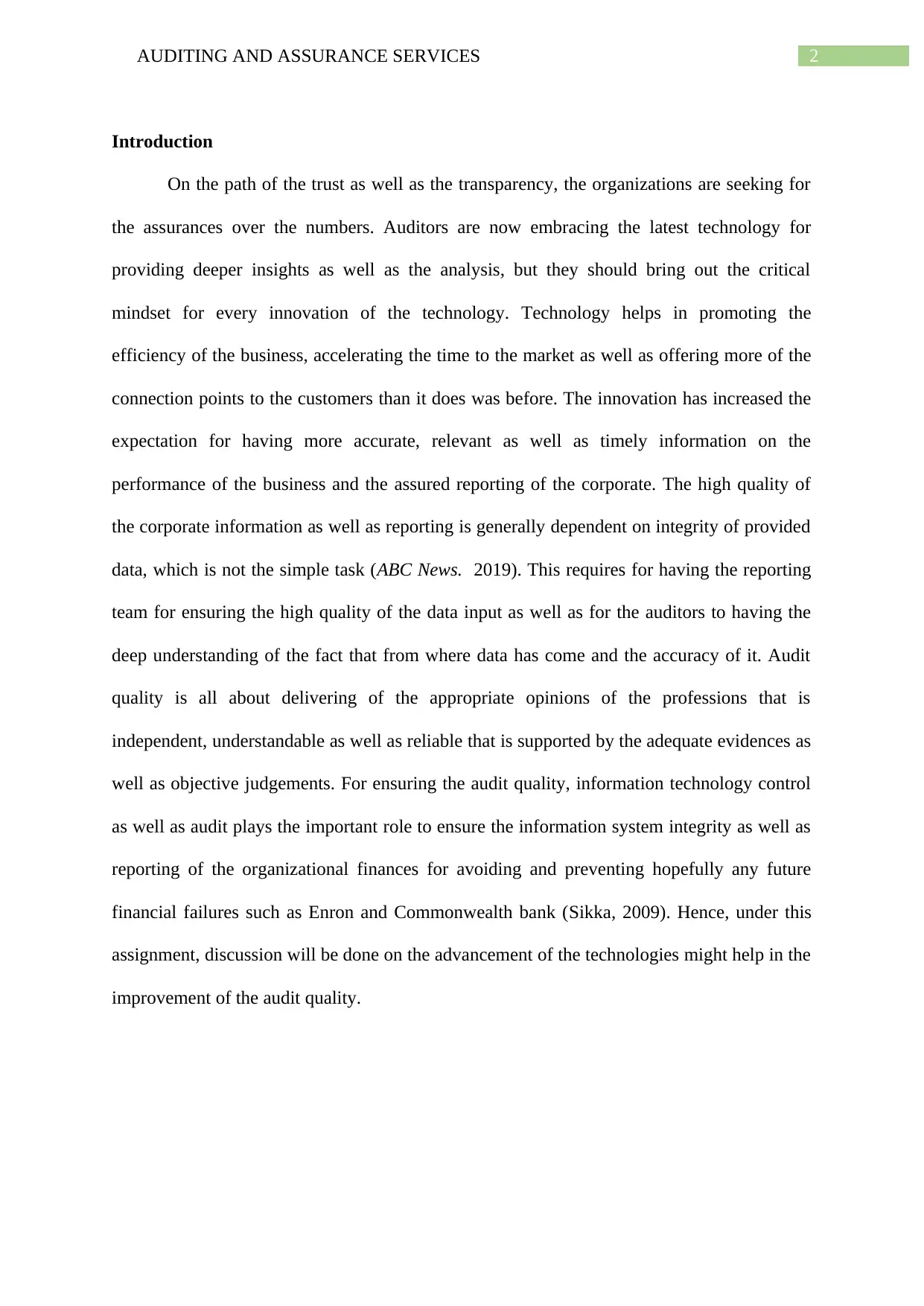
2AUDITING AND ASSURANCE SERVICES
Introduction
On the path of the trust as well as the transparency, the organizations are seeking for
the assurances over the numbers. Auditors are now embracing the latest technology for
providing deeper insights as well as the analysis, but they should bring out the critical
mindset for every innovation of the technology. Technology helps in promoting the
efficiency of the business, accelerating the time to the market as well as offering more of the
connection points to the customers than it does was before. The innovation has increased the
expectation for having more accurate, relevant as well as timely information on the
performance of the business and the assured reporting of the corporate. The high quality of
the corporate information as well as reporting is generally dependent on integrity of provided
data, which is not the simple task (ABC News. 2019). This requires for having the reporting
team for ensuring the high quality of the data input as well as for the auditors to having the
deep understanding of the fact that from where data has come and the accuracy of it. Audit
quality is all about delivering of the appropriate opinions of the professions that is
independent, understandable as well as reliable that is supported by the adequate evidences as
well as objective judgements. For ensuring the audit quality, information technology control
as well as audit plays the important role to ensure the information system integrity as well as
reporting of the organizational finances for avoiding and preventing hopefully any future
financial failures such as Enron and Commonwealth bank (Sikka, 2009). Hence, under this
assignment, discussion will be done on the advancement of the technologies might help in the
improvement of the audit quality.
Introduction
On the path of the trust as well as the transparency, the organizations are seeking for
the assurances over the numbers. Auditors are now embracing the latest technology for
providing deeper insights as well as the analysis, but they should bring out the critical
mindset for every innovation of the technology. Technology helps in promoting the
efficiency of the business, accelerating the time to the market as well as offering more of the
connection points to the customers than it does was before. The innovation has increased the
expectation for having more accurate, relevant as well as timely information on the
performance of the business and the assured reporting of the corporate. The high quality of
the corporate information as well as reporting is generally dependent on integrity of provided
data, which is not the simple task (ABC News. 2019). This requires for having the reporting
team for ensuring the high quality of the data input as well as for the auditors to having the
deep understanding of the fact that from where data has come and the accuracy of it. Audit
quality is all about delivering of the appropriate opinions of the professions that is
independent, understandable as well as reliable that is supported by the adequate evidences as
well as objective judgements. For ensuring the audit quality, information technology control
as well as audit plays the important role to ensure the information system integrity as well as
reporting of the organizational finances for avoiding and preventing hopefully any future
financial failures such as Enron and Commonwealth bank (Sikka, 2009). Hence, under this
assignment, discussion will be done on the advancement of the technologies might help in the
improvement of the audit quality.
⊘ This is a preview!⊘
Do you want full access?
Subscribe today to unlock all pages.

Trusted by 1+ million students worldwide

3AUDITING AND ASSURANCE SERVICES
Discussion
Audit Quality and Scandals
There have been many financial organizations, who have received support within the
short period of receiving the opinion of the unqualified audit. The auditors have collected the
large amounts in the fees of audit and non-audit. These events has raised the questions
regarding the company’s values, quality of the work of audit, independence of auditor,
knowledge base of the auditors as well as economic incentives for the good audits. The
conventional approach of the audit quality is incomplete as it pays less attention on the
organizational as well as social context of the auditing. The conventional approach has the
view that generally the companies have diversified into the new forms of the investments as
well as the complex financial instruments. Hence, some of the transactions will be impossible
for auditing in the traditional way (Tepalagul & Lin, 2015).
Audit quality is considered fundamental for maintaining the trust of the public as well
as is the key measures on which the reputations of the professionals stands. It is being
considered as the outcome when the audits are consistently executed on the consistent basis
that is in line with intent as well as requirements of the applicable professional standards,
which is within the strong system of the quality controls (Emerald Insight. 2019). Audit
quality is one of the foundations for instilling the confidence and the trust in capital market.
The quality of services is provided by financial auditors that has become the growing issues
over the previous few years, especially in because of the financial scandals, where auditors
has played major role. The effect of quality of audit on clients firms is because of the
credibility of audited financial statements, in case of consideration of the appropriate level of
audit quality by the stakeholders (Christensen et al. 2016).
The series of the scandals, during the year 2000 has brought into the question of the
issues of audit quality, as there were huge reforms in field of audit, which has started for
Discussion
Audit Quality and Scandals
There have been many financial organizations, who have received support within the
short period of receiving the opinion of the unqualified audit. The auditors have collected the
large amounts in the fees of audit and non-audit. These events has raised the questions
regarding the company’s values, quality of the work of audit, independence of auditor,
knowledge base of the auditors as well as economic incentives for the good audits. The
conventional approach of the audit quality is incomplete as it pays less attention on the
organizational as well as social context of the auditing. The conventional approach has the
view that generally the companies have diversified into the new forms of the investments as
well as the complex financial instruments. Hence, some of the transactions will be impossible
for auditing in the traditional way (Tepalagul & Lin, 2015).
Audit quality is considered fundamental for maintaining the trust of the public as well
as is the key measures on which the reputations of the professionals stands. It is being
considered as the outcome when the audits are consistently executed on the consistent basis
that is in line with intent as well as requirements of the applicable professional standards,
which is within the strong system of the quality controls (Emerald Insight. 2019). Audit
quality is one of the foundations for instilling the confidence and the trust in capital market.
The quality of services is provided by financial auditors that has become the growing issues
over the previous few years, especially in because of the financial scandals, where auditors
has played major role. The effect of quality of audit on clients firms is because of the
credibility of audited financial statements, in case of consideration of the appropriate level of
audit quality by the stakeholders (Christensen et al. 2016).
The series of the scandals, during the year 2000 has brought into the question of the
issues of audit quality, as there were huge reforms in field of audit, which has started for
Paraphrase This Document
Need a fresh take? Get an instant paraphrase of this document with our AI Paraphraser
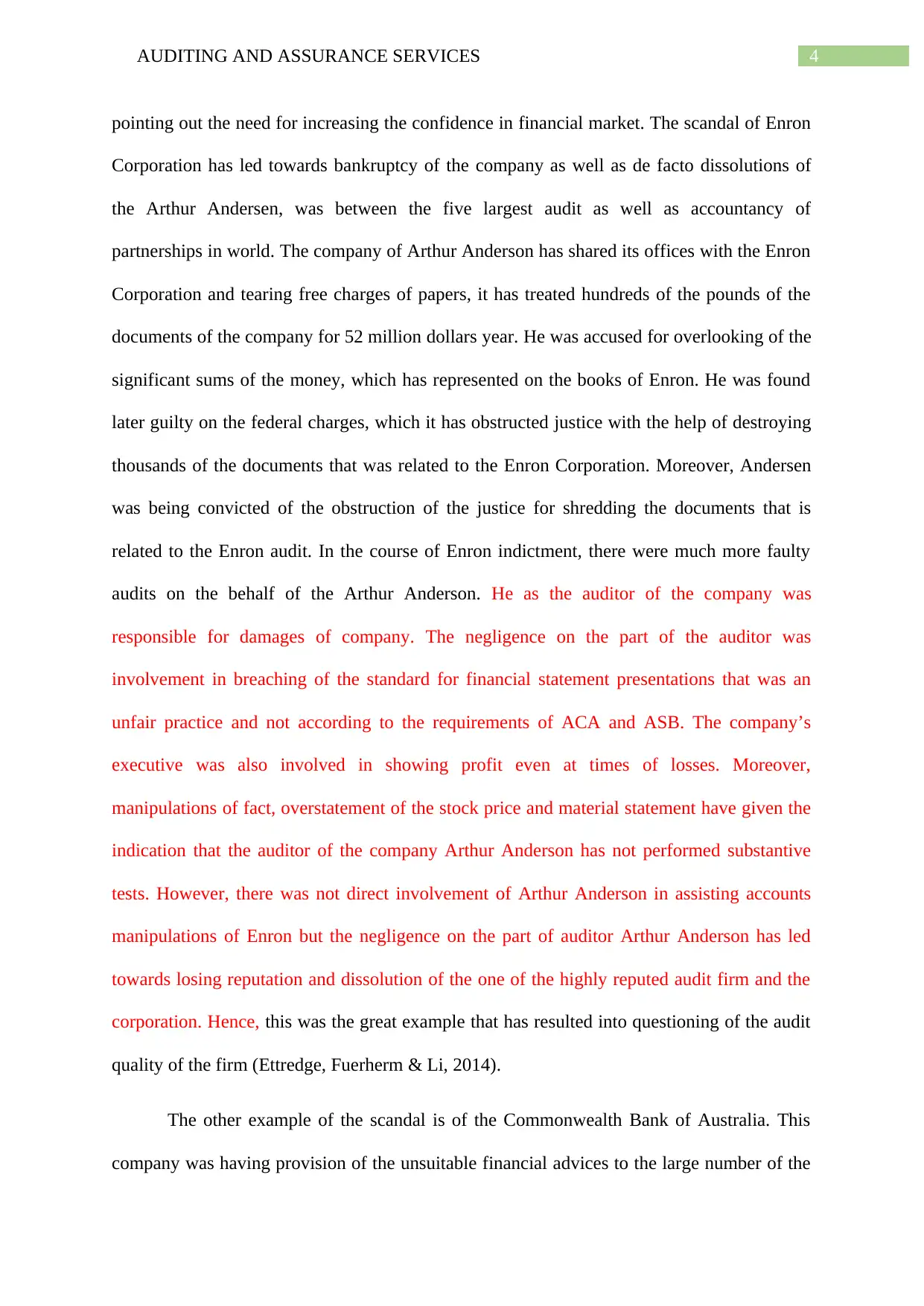
4AUDITING AND ASSURANCE SERVICES
pointing out the need for increasing the confidence in financial market. The scandal of Enron
Corporation has led towards bankruptcy of the company as well as de facto dissolutions of
the Arthur Andersen, was between the five largest audit as well as accountancy of
partnerships in world. The company of Arthur Anderson has shared its offices with the Enron
Corporation and tearing free charges of papers, it has treated hundreds of the pounds of the
documents of the company for 52 million dollars year. He was accused for overlooking of the
significant sums of the money, which has represented on the books of Enron. He was found
later guilty on the federal charges, which it has obstructed justice with the help of destroying
thousands of the documents that was related to the Enron Corporation. Moreover, Andersen
was being convicted of the obstruction of the justice for shredding the documents that is
related to the Enron audit. In the course of Enron indictment, there were much more faulty
audits on the behalf of the Arthur Anderson. He as the auditor of the company was
responsible for damages of company. The negligence on the part of the auditor was
involvement in breaching of the standard for financial statement presentations that was an
unfair practice and not according to the requirements of ACA and ASB. The company’s
executive was also involved in showing profit even at times of losses. Moreover,
manipulations of fact, overstatement of the stock price and material statement have given the
indication that the auditor of the company Arthur Anderson has not performed substantive
tests. However, there was not direct involvement of Arthur Anderson in assisting accounts
manipulations of Enron but the negligence on the part of auditor Arthur Anderson has led
towards losing reputation and dissolution of the one of the highly reputed audit firm and the
corporation. Hence, this was the great example that has resulted into questioning of the audit
quality of the firm (Ettredge, Fuerherm & Li, 2014).
The other example of the scandal is of the Commonwealth Bank of Australia. This
company was having provision of the unsuitable financial advices to the large number of the
pointing out the need for increasing the confidence in financial market. The scandal of Enron
Corporation has led towards bankruptcy of the company as well as de facto dissolutions of
the Arthur Andersen, was between the five largest audit as well as accountancy of
partnerships in world. The company of Arthur Anderson has shared its offices with the Enron
Corporation and tearing free charges of papers, it has treated hundreds of the pounds of the
documents of the company for 52 million dollars year. He was accused for overlooking of the
significant sums of the money, which has represented on the books of Enron. He was found
later guilty on the federal charges, which it has obstructed justice with the help of destroying
thousands of the documents that was related to the Enron Corporation. Moreover, Andersen
was being convicted of the obstruction of the justice for shredding the documents that is
related to the Enron audit. In the course of Enron indictment, there were much more faulty
audits on the behalf of the Arthur Anderson. He as the auditor of the company was
responsible for damages of company. The negligence on the part of the auditor was
involvement in breaching of the standard for financial statement presentations that was an
unfair practice and not according to the requirements of ACA and ASB. The company’s
executive was also involved in showing profit even at times of losses. Moreover,
manipulations of fact, overstatement of the stock price and material statement have given the
indication that the auditor of the company Arthur Anderson has not performed substantive
tests. However, there was not direct involvement of Arthur Anderson in assisting accounts
manipulations of Enron but the negligence on the part of auditor Arthur Anderson has led
towards losing reputation and dissolution of the one of the highly reputed audit firm and the
corporation. Hence, this was the great example that has resulted into questioning of the audit
quality of the firm (Ettredge, Fuerherm & Li, 2014).
The other example of the scandal is of the Commonwealth Bank of Australia. This
company was having provision of the unsuitable financial advices to the large number of the

5AUDITING AND ASSURANCE SERVICES
customers in between the year 2003 and the year 2012 as well as continuous delay in
providing of the compensations to the victims. The failures of the bank have allowed the
money laundering. The banking royal commission grilled the CEO as well as chairman of
CBA for involving in money laundering case. Yuen Hong Fung was on one of the criminal
who have used the teller machines for laundering the proceeds of the sales drug out of
country. He have attempted for opening accounts of CBA with the dozens of the fake
identities. He was able for using the Intelligent Deposit Machines of bank for depositing
$670,420 in one day. This case of money laundering has created the scandal, which has
engulfed the business as well as cast the light on behavior of banking sector of nation and its
links with the trade of global drug. Hence, in this particular case, the audit committee of
board has not taken the findings of audit seriously enough (Ettredge, Fuerherm & Li, 2014).
Both the scandals described above have raised the serious questions in relation to
audit quality. It has been found that in the recent years, there have been major decline in the
quality of the auditors. Hence, in order to reduce the audit risk, information technology is
helping the auditors for reducing the likelihood of the errors in the work of audit and increase
probability of the discovery that in turns leads towards audit risk reduction by the help of
electronic processing of data as well as electronic auditing. In this context, the chairman of
ASIC has warned the escalating conflicts of the interest in global profession of auditing,
which would results into the collapses of corporate on Enron scale (Australian Financial
Review. 2019).
Restructured Code of Ethics
The increase in the scandals has given rise to follow the ethical standard by the
accountants and the respective organization. The individual accountant have the power of
making the right set of decisions, from the ethical perspectives, they exercises their
responsibilities for behaving in the ethical manner. The accountants have ability for knowing
customers in between the year 2003 and the year 2012 as well as continuous delay in
providing of the compensations to the victims. The failures of the bank have allowed the
money laundering. The banking royal commission grilled the CEO as well as chairman of
CBA for involving in money laundering case. Yuen Hong Fung was on one of the criminal
who have used the teller machines for laundering the proceeds of the sales drug out of
country. He have attempted for opening accounts of CBA with the dozens of the fake
identities. He was able for using the Intelligent Deposit Machines of bank for depositing
$670,420 in one day. This case of money laundering has created the scandal, which has
engulfed the business as well as cast the light on behavior of banking sector of nation and its
links with the trade of global drug. Hence, in this particular case, the audit committee of
board has not taken the findings of audit seriously enough (Ettredge, Fuerherm & Li, 2014).
Both the scandals described above have raised the serious questions in relation to
audit quality. It has been found that in the recent years, there have been major decline in the
quality of the auditors. Hence, in order to reduce the audit risk, information technology is
helping the auditors for reducing the likelihood of the errors in the work of audit and increase
probability of the discovery that in turns leads towards audit risk reduction by the help of
electronic processing of data as well as electronic auditing. In this context, the chairman of
ASIC has warned the escalating conflicts of the interest in global profession of auditing,
which would results into the collapses of corporate on Enron scale (Australian Financial
Review. 2019).
Restructured Code of Ethics
The increase in the scandals has given rise to follow the ethical standard by the
accountants and the respective organization. The individual accountant have the power of
making the right set of decisions, from the ethical perspectives, they exercises their
responsibilities for behaving in the ethical manner. The accountants have ability for knowing
⊘ This is a preview!⊘
Do you want full access?
Subscribe today to unlock all pages.

Trusted by 1+ million students worldwide
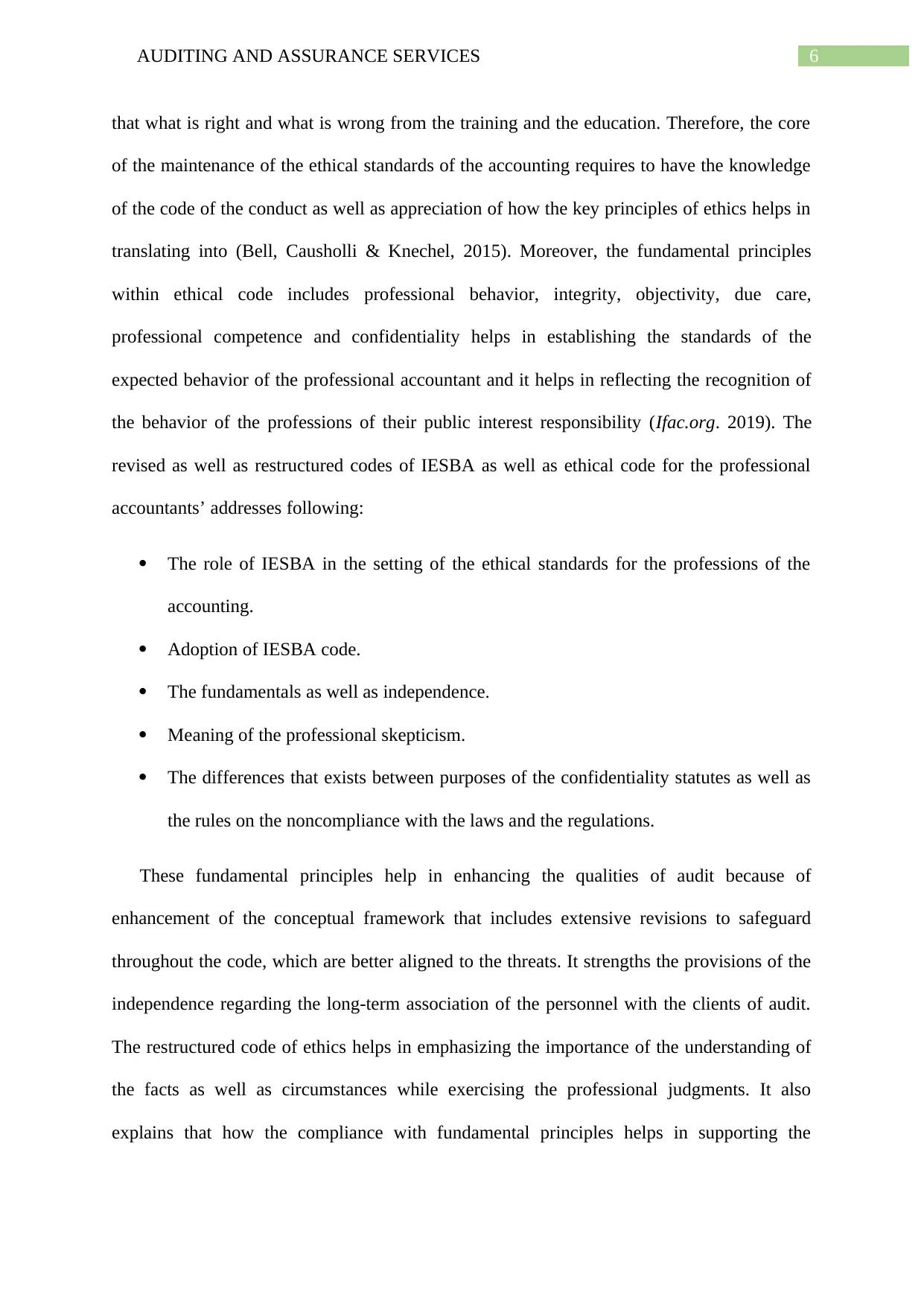
6AUDITING AND ASSURANCE SERVICES
that what is right and what is wrong from the training and the education. Therefore, the core
of the maintenance of the ethical standards of the accounting requires to have the knowledge
of the code of the conduct as well as appreciation of how the key principles of ethics helps in
translating into (Bell, Causholli & Knechel, 2015). Moreover, the fundamental principles
within ethical code includes professional behavior, integrity, objectivity, due care,
professional competence and confidentiality helps in establishing the standards of the
expected behavior of the professional accountant and it helps in reflecting the recognition of
the behavior of the professions of their public interest responsibility (Ifac.org. 2019). The
revised as well as restructured codes of IESBA as well as ethical code for the professional
accountants’ addresses following:
The role of IESBA in the setting of the ethical standards for the professions of the
accounting.
Adoption of IESBA code.
The fundamentals as well as independence.
Meaning of the professional skepticism.
The differences that exists between purposes of the confidentiality statutes as well as
the rules on the noncompliance with the laws and the regulations.
These fundamental principles help in enhancing the qualities of audit because of
enhancement of the conceptual framework that includes extensive revisions to safeguard
throughout the code, which are better aligned to the threats. It strengths the provisions of the
independence regarding the long-term association of the personnel with the clients of audit.
The restructured code of ethics helps in emphasizing the importance of the understanding of
the facts as well as circumstances while exercising the professional judgments. It also
explains that how the compliance with fundamental principles helps in supporting the
that what is right and what is wrong from the training and the education. Therefore, the core
of the maintenance of the ethical standards of the accounting requires to have the knowledge
of the code of the conduct as well as appreciation of how the key principles of ethics helps in
translating into (Bell, Causholli & Knechel, 2015). Moreover, the fundamental principles
within ethical code includes professional behavior, integrity, objectivity, due care,
professional competence and confidentiality helps in establishing the standards of the
expected behavior of the professional accountant and it helps in reflecting the recognition of
the behavior of the professions of their public interest responsibility (Ifac.org. 2019). The
revised as well as restructured codes of IESBA as well as ethical code for the professional
accountants’ addresses following:
The role of IESBA in the setting of the ethical standards for the professions of the
accounting.
Adoption of IESBA code.
The fundamentals as well as independence.
Meaning of the professional skepticism.
The differences that exists between purposes of the confidentiality statutes as well as
the rules on the noncompliance with the laws and the regulations.
These fundamental principles help in enhancing the qualities of audit because of
enhancement of the conceptual framework that includes extensive revisions to safeguard
throughout the code, which are better aligned to the threats. It strengths the provisions of the
independence regarding the long-term association of the personnel with the clients of audit.
The restructured code of ethics helps in emphasizing the importance of the understanding of
the facts as well as circumstances while exercising the professional judgments. It also
explains that how the compliance with fundamental principles helps in supporting the
Paraphrase This Document
Need a fresh take? Get an instant paraphrase of this document with our AI Paraphraser
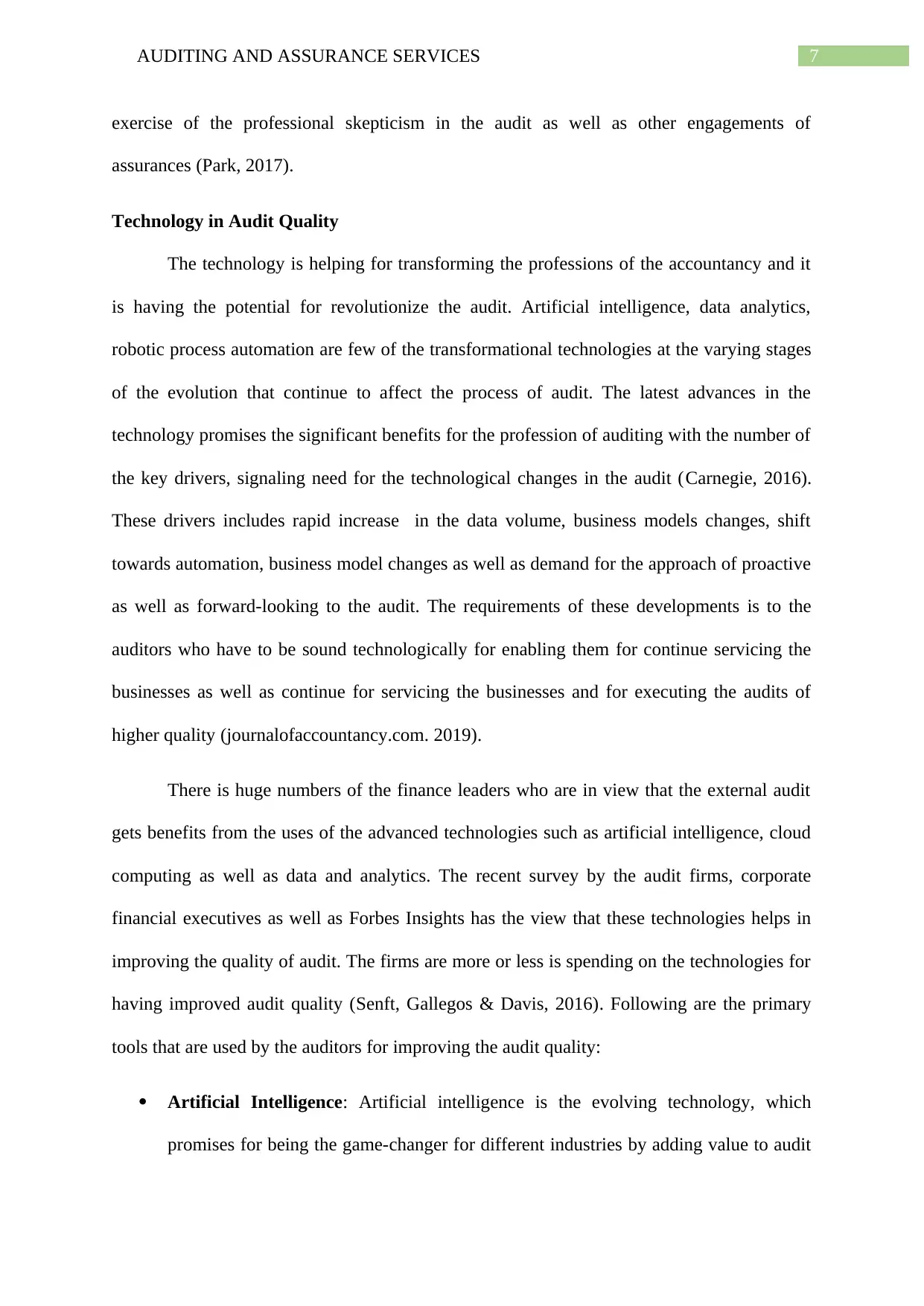
7AUDITING AND ASSURANCE SERVICES
exercise of the professional skepticism in the audit as well as other engagements of
assurances (Park, 2017).
Technology in Audit Quality
The technology is helping for transforming the professions of the accountancy and it
is having the potential for revolutionize the audit. Artificial intelligence, data analytics,
robotic process automation are few of the transformational technologies at the varying stages
of the evolution that continue to affect the process of audit. The latest advances in the
technology promises the significant benefits for the profession of auditing with the number of
the key drivers, signaling need for the technological changes in the audit (Carnegie, 2016).
These drivers includes rapid increase in the data volume, business models changes, shift
towards automation, business model changes as well as demand for the approach of proactive
as well as forward-looking to the audit. The requirements of these developments is to the
auditors who have to be sound technologically for enabling them for continue servicing the
businesses as well as continue for servicing the businesses and for executing the audits of
higher quality (journalofaccountancy.com. 2019).
There is huge numbers of the finance leaders who are in view that the external audit
gets benefits from the uses of the advanced technologies such as artificial intelligence, cloud
computing as well as data and analytics. The recent survey by the audit firms, corporate
financial executives as well as Forbes Insights has the view that these technologies helps in
improving the quality of audit. The firms are more or less is spending on the technologies for
having improved audit quality (Senft, Gallegos & Davis, 2016). Following are the primary
tools that are used by the auditors for improving the audit quality:
Artificial Intelligence: Artificial intelligence is the evolving technology, which
promises for being the game-changer for different industries by adding value to audit
exercise of the professional skepticism in the audit as well as other engagements of
assurances (Park, 2017).
Technology in Audit Quality
The technology is helping for transforming the professions of the accountancy and it
is having the potential for revolutionize the audit. Artificial intelligence, data analytics,
robotic process automation are few of the transformational technologies at the varying stages
of the evolution that continue to affect the process of audit. The latest advances in the
technology promises the significant benefits for the profession of auditing with the number of
the key drivers, signaling need for the technological changes in the audit (Carnegie, 2016).
These drivers includes rapid increase in the data volume, business models changes, shift
towards automation, business model changes as well as demand for the approach of proactive
as well as forward-looking to the audit. The requirements of these developments is to the
auditors who have to be sound technologically for enabling them for continue servicing the
businesses as well as continue for servicing the businesses and for executing the audits of
higher quality (journalofaccountancy.com. 2019).
There is huge numbers of the finance leaders who are in view that the external audit
gets benefits from the uses of the advanced technologies such as artificial intelligence, cloud
computing as well as data and analytics. The recent survey by the audit firms, corporate
financial executives as well as Forbes Insights has the view that these technologies helps in
improving the quality of audit. The firms are more or less is spending on the technologies for
having improved audit quality (Senft, Gallegos & Davis, 2016). Following are the primary
tools that are used by the auditors for improving the audit quality:
Artificial Intelligence: Artificial intelligence is the evolving technology, which
promises for being the game-changer for different industries by adding value to audit
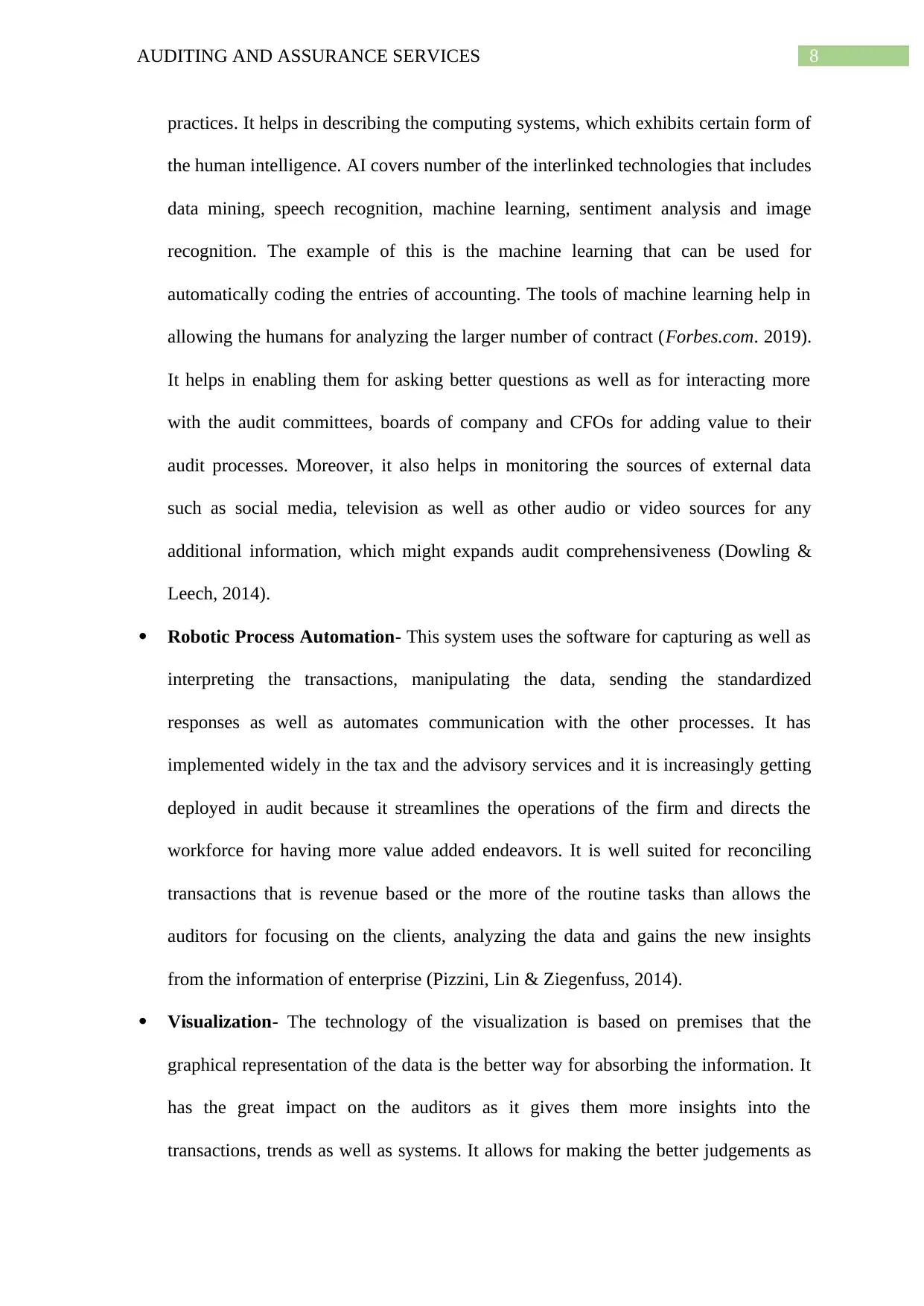
8AUDITING AND ASSURANCE SERVICES
practices. It helps in describing the computing systems, which exhibits certain form of
the human intelligence. AI covers number of the interlinked technologies that includes
data mining, speech recognition, machine learning, sentiment analysis and image
recognition. The example of this is the machine learning that can be used for
automatically coding the entries of accounting. The tools of machine learning help in
allowing the humans for analyzing the larger number of contract (Forbes.com. 2019).
It helps in enabling them for asking better questions as well as for interacting more
with the audit committees, boards of company and CFOs for adding value to their
audit processes. Moreover, it also helps in monitoring the sources of external data
such as social media, television as well as other audio or video sources for any
additional information, which might expands audit comprehensiveness (Dowling &
Leech, 2014).
Robotic Process Automation- This system uses the software for capturing as well as
interpreting the transactions, manipulating the data, sending the standardized
responses as well as automates communication with the other processes. It has
implemented widely in the tax and the advisory services and it is increasingly getting
deployed in audit because it streamlines the operations of the firm and directs the
workforce for having more value added endeavors. It is well suited for reconciling
transactions that is revenue based or the more of the routine tasks than allows the
auditors for focusing on the clients, analyzing the data and gains the new insights
from the information of enterprise (Pizzini, Lin & Ziegenfuss, 2014).
Visualization- The technology of the visualization is based on premises that the
graphical representation of the data is the better way for absorbing the information. It
has the great impact on the auditors as it gives them more insights into the
transactions, trends as well as systems. It allows for making the better judgements as
practices. It helps in describing the computing systems, which exhibits certain form of
the human intelligence. AI covers number of the interlinked technologies that includes
data mining, speech recognition, machine learning, sentiment analysis and image
recognition. The example of this is the machine learning that can be used for
automatically coding the entries of accounting. The tools of machine learning help in
allowing the humans for analyzing the larger number of contract (Forbes.com. 2019).
It helps in enabling them for asking better questions as well as for interacting more
with the audit committees, boards of company and CFOs for adding value to their
audit processes. Moreover, it also helps in monitoring the sources of external data
such as social media, television as well as other audio or video sources for any
additional information, which might expands audit comprehensiveness (Dowling &
Leech, 2014).
Robotic Process Automation- This system uses the software for capturing as well as
interpreting the transactions, manipulating the data, sending the standardized
responses as well as automates communication with the other processes. It has
implemented widely in the tax and the advisory services and it is increasingly getting
deployed in audit because it streamlines the operations of the firm and directs the
workforce for having more value added endeavors. It is well suited for reconciling
transactions that is revenue based or the more of the routine tasks than allows the
auditors for focusing on the clients, analyzing the data and gains the new insights
from the information of enterprise (Pizzini, Lin & Ziegenfuss, 2014).
Visualization- The technology of the visualization is based on premises that the
graphical representation of the data is the better way for absorbing the information. It
has the great impact on the auditors as it gives them more insights into the
transactions, trends as well as systems. It allows for making the better judgements as
⊘ This is a preview!⊘
Do you want full access?
Subscribe today to unlock all pages.

Trusted by 1+ million students worldwide
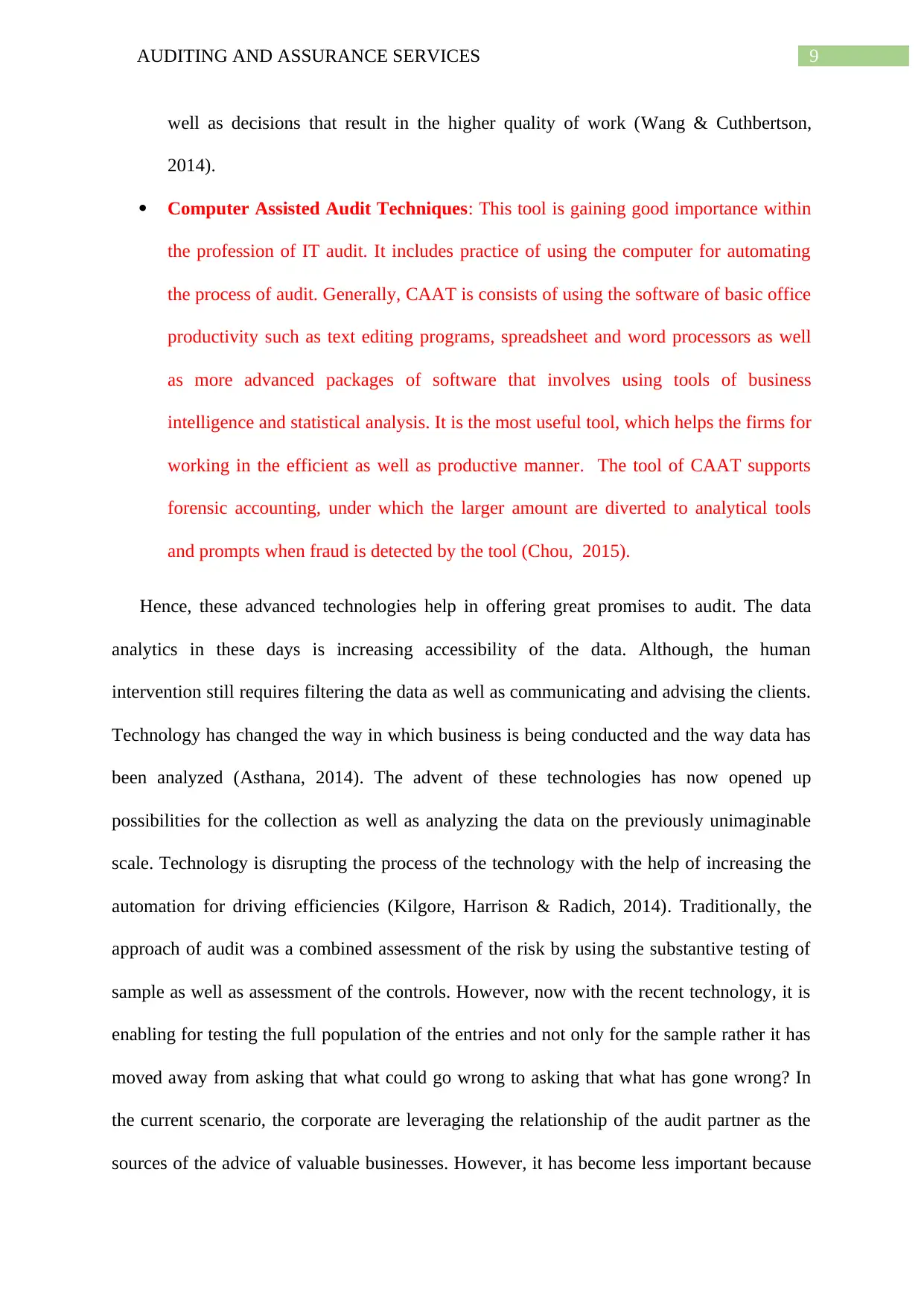
9AUDITING AND ASSURANCE SERVICES
well as decisions that result in the higher quality of work (Wang & Cuthbertson,
2014).
Computer Assisted Audit Techniques: This tool is gaining good importance within
the profession of IT audit. It includes practice of using the computer for automating
the process of audit. Generally, CAAT is consists of using the software of basic office
productivity such as text editing programs, spreadsheet and word processors as well
as more advanced packages of software that involves using tools of business
intelligence and statistical analysis. It is the most useful tool, which helps the firms for
working in the efficient as well as productive manner. The tool of CAAT supports
forensic accounting, under which the larger amount are diverted to analytical tools
and prompts when fraud is detected by the tool (Chou, 2015).
Hence, these advanced technologies help in offering great promises to audit. The data
analytics in these days is increasing accessibility of the data. Although, the human
intervention still requires filtering the data as well as communicating and advising the clients.
Technology has changed the way in which business is being conducted and the way data has
been analyzed (Asthana, 2014). The advent of these technologies has now opened up
possibilities for the collection as well as analyzing the data on the previously unimaginable
scale. Technology is disrupting the process of the technology with the help of increasing the
automation for driving efficiencies (Kilgore, Harrison & Radich, 2014). Traditionally, the
approach of audit was a combined assessment of the risk by using the substantive testing of
sample as well as assessment of the controls. However, now with the recent technology, it is
enabling for testing the full population of the entries and not only for the sample rather it has
moved away from asking that what could go wrong to asking that what has gone wrong? In
the current scenario, the corporate are leveraging the relationship of the audit partner as the
sources of the advice of valuable businesses. However, it has become less important because
well as decisions that result in the higher quality of work (Wang & Cuthbertson,
2014).
Computer Assisted Audit Techniques: This tool is gaining good importance within
the profession of IT audit. It includes practice of using the computer for automating
the process of audit. Generally, CAAT is consists of using the software of basic office
productivity such as text editing programs, spreadsheet and word processors as well
as more advanced packages of software that involves using tools of business
intelligence and statistical analysis. It is the most useful tool, which helps the firms for
working in the efficient as well as productive manner. The tool of CAAT supports
forensic accounting, under which the larger amount are diverted to analytical tools
and prompts when fraud is detected by the tool (Chou, 2015).
Hence, these advanced technologies help in offering great promises to audit. The data
analytics in these days is increasing accessibility of the data. Although, the human
intervention still requires filtering the data as well as communicating and advising the clients.
Technology has changed the way in which business is being conducted and the way data has
been analyzed (Asthana, 2014). The advent of these technologies has now opened up
possibilities for the collection as well as analyzing the data on the previously unimaginable
scale. Technology is disrupting the process of the technology with the help of increasing the
automation for driving efficiencies (Kilgore, Harrison & Radich, 2014). Traditionally, the
approach of audit was a combined assessment of the risk by using the substantive testing of
sample as well as assessment of the controls. However, now with the recent technology, it is
enabling for testing the full population of the entries and not only for the sample rather it has
moved away from asking that what could go wrong to asking that what has gone wrong? In
the current scenario, the corporate are leveraging the relationship of the audit partner as the
sources of the advice of valuable businesses. However, it has become less important because
Paraphrase This Document
Need a fresh take? Get an instant paraphrase of this document with our AI Paraphraser
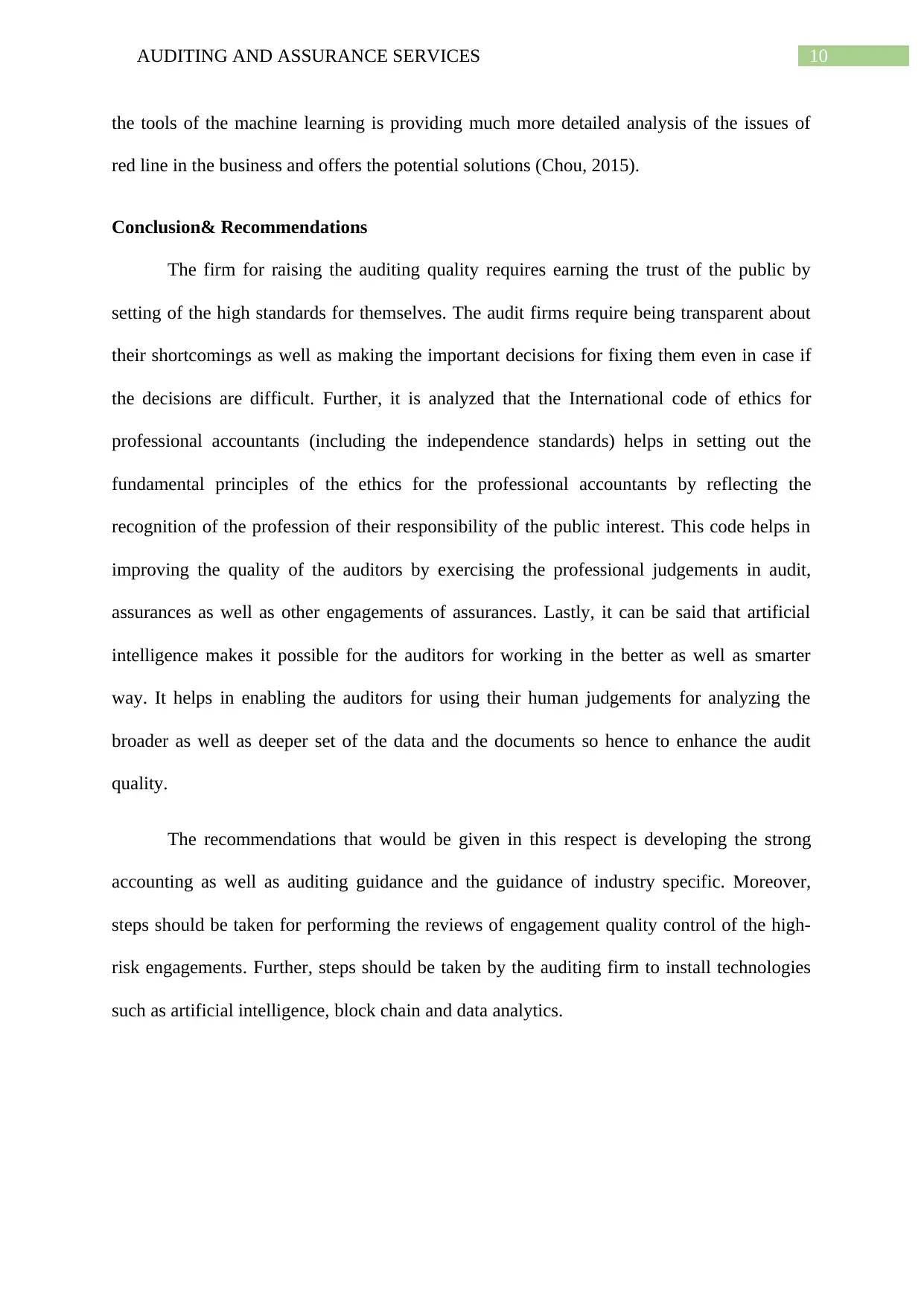
10AUDITING AND ASSURANCE SERVICES
the tools of the machine learning is providing much more detailed analysis of the issues of
red line in the business and offers the potential solutions (Chou, 2015).
Conclusion& Recommendations
The firm for raising the auditing quality requires earning the trust of the public by
setting of the high standards for themselves. The audit firms require being transparent about
their shortcomings as well as making the important decisions for fixing them even in case if
the decisions are difficult. Further, it is analyzed that the International code of ethics for
professional accountants (including the independence standards) helps in setting out the
fundamental principles of the ethics for the professional accountants by reflecting the
recognition of the profession of their responsibility of the public interest. This code helps in
improving the quality of the auditors by exercising the professional judgements in audit,
assurances as well as other engagements of assurances. Lastly, it can be said that artificial
intelligence makes it possible for the auditors for working in the better as well as smarter
way. It helps in enabling the auditors for using their human judgements for analyzing the
broader as well as deeper set of the data and the documents so hence to enhance the audit
quality.
The recommendations that would be given in this respect is developing the strong
accounting as well as auditing guidance and the guidance of industry specific. Moreover,
steps should be taken for performing the reviews of engagement quality control of the high-
risk engagements. Further, steps should be taken by the auditing firm to install technologies
such as artificial intelligence, block chain and data analytics.
the tools of the machine learning is providing much more detailed analysis of the issues of
red line in the business and offers the potential solutions (Chou, 2015).
Conclusion& Recommendations
The firm for raising the auditing quality requires earning the trust of the public by
setting of the high standards for themselves. The audit firms require being transparent about
their shortcomings as well as making the important decisions for fixing them even in case if
the decisions are difficult. Further, it is analyzed that the International code of ethics for
professional accountants (including the independence standards) helps in setting out the
fundamental principles of the ethics for the professional accountants by reflecting the
recognition of the profession of their responsibility of the public interest. This code helps in
improving the quality of the auditors by exercising the professional judgements in audit,
assurances as well as other engagements of assurances. Lastly, it can be said that artificial
intelligence makes it possible for the auditors for working in the better as well as smarter
way. It helps in enabling the auditors for using their human judgements for analyzing the
broader as well as deeper set of the data and the documents so hence to enhance the audit
quality.
The recommendations that would be given in this respect is developing the strong
accounting as well as auditing guidance and the guidance of industry specific. Moreover,
steps should be taken for performing the reviews of engagement quality control of the high-
risk engagements. Further, steps should be taken by the auditing firm to install technologies
such as artificial intelligence, block chain and data analytics.

11AUDITING AND ASSURANCE SERVICES
Reference
ABC News. 2019. . 'Not sceptical enough': Former ASIC boss warns audit failures could
lead to Enron-style collapse. Retrieved 29 August 2019, from
https://www.abc.net.au/news/2019-08-06/audit-firm-failures-could-spark-enron-style-
collapse-medcraft/11388164
Asthana, S. (2014). Abnormal audit delays, earnings quality and firm value in the
USA. Journal of Financial Reporting and Accounting, 12(1), 21-44.
Australian Financial Review. 2019. ASIC to name and shame big four consulting firms over
audit quality. Retrieved 29 August 2019, from
https://www.afr.com/politics/federal/asic-to-name-and-shame-big-four-consulting-
firms-over-audit-quality-20190806-p52efr
Bell, T. B., Causholli, M., &Knechel, W. R. (2015). Audit firm tenure, non‐audit services,
and internal assessments of audit quality. Journal of Accounting Research, 53(3), 461-
509.
Carnegie, G. D. (2016). The accounting professional project and bank failures: The case of
the early 1890s Australian banking crisis. Journal of Management History, 22(4),
389-412.
Chou, D. C. (2015). Cloud computing risk and audit issues. Computer Standards &
Interfaces, 42, 137-142.
Christensen, B. E., Glover, S. M., Omer, T. C., & Shelley, M. K. (2016). Understanding audit
quality: Insights from audit professionals and investors. Contemporary Accounting
Research, 33(4), 1648-1684.
Reference
ABC News. 2019. . 'Not sceptical enough': Former ASIC boss warns audit failures could
lead to Enron-style collapse. Retrieved 29 August 2019, from
https://www.abc.net.au/news/2019-08-06/audit-firm-failures-could-spark-enron-style-
collapse-medcraft/11388164
Asthana, S. (2014). Abnormal audit delays, earnings quality and firm value in the
USA. Journal of Financial Reporting and Accounting, 12(1), 21-44.
Australian Financial Review. 2019. ASIC to name and shame big four consulting firms over
audit quality. Retrieved 29 August 2019, from
https://www.afr.com/politics/federal/asic-to-name-and-shame-big-four-consulting-
firms-over-audit-quality-20190806-p52efr
Bell, T. B., Causholli, M., &Knechel, W. R. (2015). Audit firm tenure, non‐audit services,
and internal assessments of audit quality. Journal of Accounting Research, 53(3), 461-
509.
Carnegie, G. D. (2016). The accounting professional project and bank failures: The case of
the early 1890s Australian banking crisis. Journal of Management History, 22(4),
389-412.
Chou, D. C. (2015). Cloud computing risk and audit issues. Computer Standards &
Interfaces, 42, 137-142.
Christensen, B. E., Glover, S. M., Omer, T. C., & Shelley, M. K. (2016). Understanding audit
quality: Insights from audit professionals and investors. Contemporary Accounting
Research, 33(4), 1648-1684.
⊘ This is a preview!⊘
Do you want full access?
Subscribe today to unlock all pages.

Trusted by 1+ million students worldwide
1 out of 14
Related Documents
Your All-in-One AI-Powered Toolkit for Academic Success.
+13062052269
info@desklib.com
Available 24*7 on WhatsApp / Email
![[object Object]](/_next/static/media/star-bottom.7253800d.svg)
Unlock your academic potential
Copyright © 2020–2025 A2Z Services. All Rights Reserved. Developed and managed by ZUCOL.





